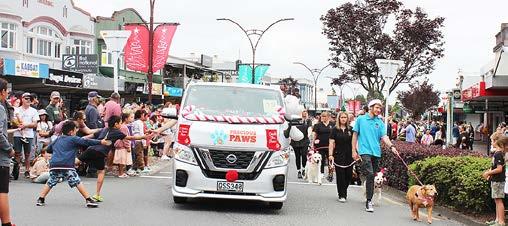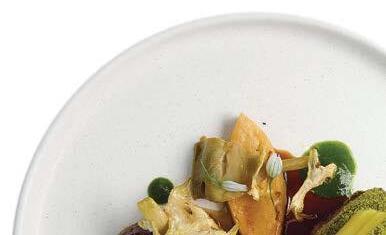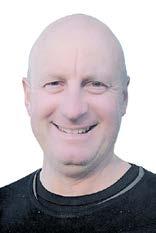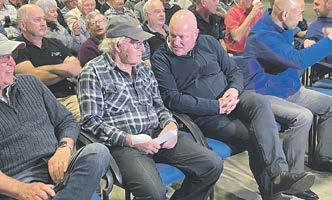





By Chris Gardner
Staff at St John’s Anglican Church in Te Awamutu have taken to sleeping over to protect the building from thieves.
Parish priest Julie Guest said staff began sleeping in the church and security systems were installed after a series of incidents beginning with the burning of a car parked in front of the church on George St early last month.
“As St John’s is a concrete structure, the building suffered only scorch marks, but the wreck was visited nightly by those seeking to further loot and destroy the remains. Shortly after that, a copper downpipe was stolen from St John’s,” Guest said.
The church stands alongside Waikato’s oldest surviving building
the Category 1 St John’s Church. Thieves hit another historic church a few days later
Spouting along one side of historical St Paul’s church in Rangiaowhia Rd, Hairini was ripped off, causing damage to the remaining roof.
“Two days after that the thieves returned to strip the spouting from the other side of St Paul’s. They just ripped it off with absolutely no care for the building. That this sacred taonga for the whole community should be ravaged in that way is hard to fathom,” Guest said.
“The worst and final discovery was that thieves have begun removing the flat roofing off St John’s, all of which is copper.
A building without spouting or downpipes is messy, but a building without a roof covering is open to
weather – on the way to ruin.
“This building has been there for 60 years, and it’s got another 60 years in it,” she said.
Police are investigating.
Guest told The News the vandalism and theft was a distraction of her church’s work to bring justice and reconciliation following the wrongs committed against Māori in the New Zealand Land Wars.
She has launched an appeal for help, asking the community to keep a close eye on her building, look out for copper roofing being offered for sale, and for financial help to assist with repairs.
“One lot of advice suggests we should remove all the copper, the entire roof and spouting on St John’s,” she said.
“Although we can claim
insurance to patch what has been stolen to date, once we lodge a claim, we will not be insured for a further claim should the thieves return.”
Guest is awaiting a quote for the removal of copper and replacement of the roof.
“Whatever we do, the cost is likely to be prohibitive, but having no roof to protect the building is not an option either. It is a dilemma that requires prayer, and whatever financial support and aid we can find,” she said.
“Please help. It’s hard to feel in the Christmas spirit and be jollying people along.”
Guest, supported by her husband Andrew, has led the parish of four churches since 2019. The Queen Mother worshipped at St John’s in 1966.
By Chris Gardner
Pirongia’s pub is up for sale after its owners failed in a final attempt to get their licence back.
Nora Fu, sole shareholder of Night Pearl Ltd, shut the Five Stags Restaurant and Bar in the middle of the year.
The Waipā District Licensing Committee declined to renew Fu’s licence early this year.
Link Business Waikato real estate agent Therese BaileyCarter said the business was worth about $1 million but the vendor was open to offers.
“There’s been quite a lot of

interest, but it’s about getting the right person in there,” she said.
The community’s social media Facebook page has discussed the announcement.
“It’s been a ridiculous fiasco for too long,” said Peter Bridgland. “Let’s hope the community gets its pub back soon.”
“Hope we get a proprietor who loves the place and knows how to run a successful tavern-restaurant,” said Brian Derbyshire.
“We all want the pub to do well and serve the community well.”



Fu’s appeal to the Alcohol Regulatory and Licencing Authority in June failed after it heard staff continued to serve alcohol on parts of the premises not covered by the licence between hearing dates, the bar served alcohol to an underage drinker during a police-led controlled purchase operation in November 2023, and Fu failed to properly appoint and notify a duty manager. Earlier, the Employment Relations Authority ordered the company to pay more than $21,000 following the dismissal of an employee.











By Mary Anne Gill
A networking group for Waikato women was launched last week in Hamilton with
several Waipā residents signing up.
More than 120 women attended the Waikato Waahine Collective launch at Weave in Innovation Park where North End Law’s
Keryn Noorland, a member of the advisory committee, said the aim was to provide a dynamic network to empower and support women at all stages of their career.
“Our collective aims to foster a thriving community where women from diverse fields can connect, learn, and grow together,” she said.
“We are all passionate about making us a welcoming community for women working in all industries and at all stages of their careers.”
Waikato Chamber of Commerce leads the collective and Marketing and Events manager Rebecca Aston is on the committee.
Waikato had a women’s business network in the past but it “fizzled out,” she said.


“But we’re reinvigorating it today,” and adding a broader scope by empowering and supporting women at all stages of their career and across all professions in the region.
The aim was to become Waikato’s leading women’s network.



With the holiday season soon to be in full swing, the message is again one of protecting yourself from opportunistic crime, socialising sensibly and driving safely.
This week we have had a few reported burglaries, including where Christmas presents were taken, both from homes and in a vehicle.
Christmas presents like any other valuable item, when visible, attract the attention of passing dishonesty offenders. In doing so, they make your car and house more likely to be targeted.
Remove any valuable items from your car and obscure Christmas present placement with regards to a passerby’s view of your home. If having courier parcels delivered, leave instructions for them to be placed out of sight. Invest in CCTV if possible as this can be a deterrent and equally provides valuable evidence of crimes if committed.
Lock your doors, don’t advertise your absence and generally be security conscious whether at home or away.
In the past week, between Cambridge and Te Awamutu police, we dealt with three drink drivers.
If you plan on socialising and will be drinking alcohol, leave the car at home and organise alternative transportation. If you are the sober driver for friends, stay soberand don’t drive if that changes.
If you see someone about to drive when


intoxicated, step in. If you can’t prevent them driving, ring 111 with vehicle details, the identity of the driver, direction of travel and their intended destination if known.
And talking of driving, our traffic staff are urging all to exercise patience when it comes to travel in the holiday period. In the past week prior to writing, between Cambridge and Te Awamutu, we have had 17 traffic crashes. This at a time when holiday traffic is nowhere near their peak.
Allowing extra time into your journey reduces stress and prevents bad driving decisions that can have long lasting impacts. Take regular breaks, maintain a decent following distance, don’t speed and drive to the conditions.
Remember to also ensure all in the vehicle are wearing their seatbelts. If you see dangerous driving likely to cause a crash, ring 111. If possible, have a passenger take a video of the bad driving behaviour to provide to police.
To end, this is my last column of 2024. Thank you to everyone who has taken their time to read my contributions over the past 12 months.
I hope you have found the information I have provided to be helpful and interesting. Have a safe and relaxing Christmas and New Year.
“Our mission is simple. It’s to create opportunities for women to connect, celebrate success and share their experiences through events like this.”
The first event will be in March with a panel discussion and International Women’s Day breakfast at Waikato University followed by a speaker series, which will become the collective’s annual signature event.
“Our plan for this is to create a day where women can connect with one another from all over the Waikato and hear from inspiring speakers,” said Aston.




Pirongia park
Skate park concept designs for Pirongia are being finalised following community consultation earlier this year.
The adjacent playground has been included in the project which will draw on community fundraising activities and Waipā District Council to fund.
Consultation with iwi is underway for the renewal of the playground in Hiskens Place Reserve, Te Awamutu.
Waipā council has also conducted a customer survey. Construction should start later next year.
The Te Awamutu Food Forest continues to attract strong community support and more garden beds for vegetables have been developed in Pekarau Reserve, where a wastewater upgrade is due for completing this month.
Waipā jockey James McDonald soon to join the Cambridge Sports Walk of Fame, has been named the world’s best jockey for the second time in three years. Kaipaki born McDonald received his trophy in Hong Kong last Friday.
Venues in finals
Cambridge Town Hall missed out on Entertainment Venues Association small venue of the year award at the association’s annual awards in Auckland last week. It was pipped to the under 1000 seat title by The Turner Centre of Kerikeri. Mystery Creek Events Centre lost out to Go Media Stadium for the large venue of the year title.
The Lake Karāpiro Christmas regatta which gets underway tomorrow for three days is the largest ever held in New Zealand with more than 2600 rowers competing on the lake. There will be a 2000m race held every four minutes over 10 hours each of the three days, organisers say.
By Chris Gardner
An endowment fund is being launched to fund the ongoing replacement of the world’s largest predator proof fence
If the fund reaches its $42 million target it would return $2 million a year, Sanctuary Mountain Maungatautari chief executive Helen Hughes told Tuesday’s meeting of Waipā District Council’s Maungatautari Reserve Committee.
Hughes was presenting on the Maungatautari Ecological Island Trust trust’s annual operational management plan which council community services manager Brad Ward bought before the committee for approval. The trust’s service agreement
with the council includes having the plan approved, Ward said.
“We are replacing segments of the fence as every breach happens, and an average is a 30-year life span,” Hughes said.
She expected the cost of full replacement of the fence protecting 3363 hectares of mountain reserve to be around $40 million – double what it cost to build about 20 years ago.
Parts of the fence are replaced periodically thought the trust’s maintenance programme - sometimes it simply involves replacing rivets.
Hughes was responding to a question from Cambridge Ward councillor Roger Gordon who was concerned
about the life of the fence and the cost of replacing it.
The trust made a $500,000 loss – most of it in depreciation – in the financial year to June 30 after the Department of Conservation withdrew funding from the project.
When it was set up, the $5000 a day project was funded equally by the conservation department, Waipā District Council and Waikato Regional Council.
Following the loss of funding the trust had shed eight rangers. It is now operating with six, and as a result what Hughes called halo work – trapping predators outside of the predator proof fence – had been cut from the work programme.
The cuts have also pushed her team to their limits at times of storm damage when fallen trees and branches breach the fence and repair work is required quickly.
Hughes shared frustration that the trust’s application for a Lottery Grant for $400,000 had been declined, although it had been encouraged to resubmit a $250,000 application in the New Year.
The trust has also applied for further help from the Department of Conservation and had hired a tourism marketing specialist who was working on raising the project’s profile.
Hughes shared the vision of the project eventually becoming self-funded with the development of a new



tour tailored to visitors to Hobbiton and Waitomo and the development of a Kiwi experience.
“We have 3000 kiwi that live on the maunga,” Hughes said. “There will be a point when Maungtautari might become full.”
Maungatautari Ward councillors and committee chair Mike Montgomerie said he regularly heard kiwi from his front door every night. He described it as “a total taonga”.
The committee unanimously voted to accept the trust’s operational management plan.
By Mary Anne Gill
Three Waipā food premises have been issued with improvement notices since October and two in Te Awamutu ordered to close because of unsafe food practices.
The other in Leamington was allowed to remain open.
And an unregistered mobile food business has also been issued with two infringement notices from Waipā District Council.
The notices were issued due to hygiene, food storage and related concerns.
The names of the outlets have been withheld as doing so would “unreasonably prejudice their commercial position,” said manager Karl Tutty.
Tutty said one of the Te Awamutu premises had now complied with the improvement notice and reopened, the other was working through the requirements.
All food businesses must be registered under the Food Act and have a Food Control Plan or a National Programme.
By Peter Carr
Conscious that this is my last opinion offering for 2024 I have elected to be a little reflective with a wee touch of future thinking.
This has been – and continues to be – a turbulent year.
Politically it’s been rather messy, a huge list of promises not yet achieved, a rather silly tit-for-tat series of exchanges where the political authors know they can do better.
A socio-economic picture hints at third world experiences coupled with a mad scrambling to grow trees on land that is ideal for ‘proper’ farming - in the name of some foggy carbon credit idealism that many countries ignore. The idealism of the Paris agreement long gone despite all the rhetoric that abounds.
The Green Party, staggering from intradestructive embarrassment, the Māori Party showing their true colours and a tripartite political governance that struggles to hold together promises.
Back in 1993 I voted against MMP and still maintain that we were – and still are – going down a path which, when coupled with three-year parliaments, aids an appearance of little hope for our younger people.
My 16-year-old grandson who is achieving well at school shocked me with a statement that he doubts if he will ever be able to own a house.
Possibly the best advice I can give him – which grieves me – is that he looks at purchasing an Australian residence. Reading we are short of nurses, yet nursing graduates are turned away by employers just does not resonate for me.
And we now hear the Post Office is planning a major reduction in delivery
services, possibly culling 300 outlets.
And we are about to lurch into about seven weeks of television darkness as regard current affairs

. The regular (and popular) Q&A has shut down until late January (or possibly beyond).
In the week prior to Christmas the now monopolistic TV1 will withdraw all morning news efforts until late January.
Imagine if the editors of the major dailies decided to take five weeks off from their regular work?
Yet freely distributed organs like the one you are currently reading only take a short break despite a very large number of them being culled at this moment.
But there must be some light at the end of the tunnel – even if we cannot find the entrance to it.
The pundits would have us believe that we move in cycles – which is partly correct – but the centres of the cycles keep lowering on each round.
My hope is always that there must be a brighter future for our young people.
I was enthralled by the frenzied dancing, singing and stamping of an intermediate school’s Māori group last week at Waipa council’s annual mayoral social and explanatory function.
Girls standing on the floor with the boys on the stage behind. The stomping by the boys’ feet was so thundering I feared for the safety of the stage floor.
But several people around me despaired at the waving of the (wrongly named) Māori flag by one of the students.




By Christine Bryant, Lay Minister, St John’s Anglican Church
In Matthew’s gospel, Chapter 6, Jesus teaches: “Do not store up for yourselves treasures on earth where moth and rust destroy, and thieves break in and steal. But store up for yourselves treasures in heaven… for where your treasure is, there will your heart be also”.
In Te Awamutu we are fortunate to have the only two Category 1 listed buildings in the whole of the Waikato.
As parishioners of St John’s, we are privileged to be able to worship where six or seven generations of Māori and Pakeha Christians have worshiped for 170 years.
We take seriously our responsibility to maintain the four churches in our care. The two historic churches, in particular, are special places.
Many people step into them and are immediately moved by the spirit which inhabits them, the spirit which comes from generations who have worshiped Jesus.
Recently two of our buildings have been attacked by vandals.
This truly upsetting. It is upsetting, firstly, because it is deeply disrespectful of the faith of our tupuna who include the Rev. John Morgan and his wife, Maria, who were amongst the earliest missionaries in the Waikato, and Irihāpeti Te Paea Pōtatau, the half-sister of the second Māori king, Tāwhiao, who gave her personal protection to Old St John’s and prevented it from being destroyed in retribution for the tragedy at Rangiaowhia.
Secondly, it is upsetting because the damage needs to be repaired, and it is costly to do so.
We are grateful to God for the places of worship in our care, but the prime mission






of the church is not to spend its limited funds on buildings. It is to share God’s love by caring for those in need in our community.
Funds diverted needlessly to repair vandalism are funds that would otherwise be used to feed hungry families, provide affordable holiday programmes for children and reach out in friendship to the “last, the lost and the least” (Archbishop Justin, Wellington).
Do we hate the vandals? No, of course not. But we do pray that they can kick the drug habit which is driving them to commit vandalism in order to get their next fix.
We pray that they turn their focus into being a positive influence in the community.
The historic churches of Te Awamutu are taonga for us all, Māori and Pakeha, Christian and non-Christian.
The actions of a few thoughtless people create a risk of losing this heritage.

We do want to pass these churches and their stories down to our grandchildren and great-grandchildren. Our simple timber churches may not have the grandeur of the newly restored Notre Dame de Paris, nevertheless, in the same way that Notre Dame is testament to eight centuries of worship, they are a precious witness to the love of Christ which brought Māori and Pakeha to worship together in the 1850s and which, more than 2000 years after the birth of Christ, still has the power to bring all people together today.






















By Mary Anne Gill
The couple behind plans to open a charter school in Cambridge have not given up on their plans following an announcement they are not among the latest to get the government’s green light.
Maxine and Ray Nelson of Ignite Arts Academy say they will plough ahead with their application hoping they will be among the next lot of charter schools.
Associate education minister David Seymour last
week said charter schools in Christchurch, Kaitaia and three in Auckland would open for term one next year.
They join a Christchurch school announced last month.
“We see this as just a delay at the moment and have received much positive feedback from the community and families in the Cambridge area,” Ray Nelson said.
“Our plan is to keep pressing forward and planning for a successful outcome.”
Seymour says charter schools will make New Zealand’s education system more flexible and responsive to family and student needs, and has indicated more announcements will be made.
“This is just the beginning. I hope to see many more new charter schools opening, and state and state-integrated schools converting to become charter schools.”
The Nelson application was one of four submitted with the assistance of charter
school pioneer Alwyn Poole who lashed out at Seymour saying the process was “deeply unfair”.
Asked by The News whether the spat between Seymour and Poole might hurt their application, the Nelsons were unconcerned saying their proposal had already attracted significant support in the Cambridge community.
“We already have an existing facility, and we can start with 90 students,” said Ray Nelson.
It was the lack of feedback which was hindering them.
“We just need the go ahead.”
The Nelsons say they have backers, job applicants and students waiting. Their application is a mix of academia and culture with class sizes of 15 students to a teacher.
All charter schools have contracted target outcomes related to student attendance and achievement.
These targets vary depending on student year
level and school details but are set to deliver a high standard of overall student achievement, including managed progression, compared with current State schools.
Among the targets, 80 per cent of students in years 7-10 achieving at or above the expected level, 95 per cent of students in years 11-13 achieving at least NCEA level 2 in maths, English, science and one creative art and 90 per cent attendance for all students.
By Paul Charman
Ōtorohanga rail enthusiast Bill Millar is “gutted” that track maintenance will cut the Northen Explorer service to town over the festive season.
The Northern Explorer, a tourist train with a viewing car, normally visits Ōtorohanga on its northbound journey on Wednesdays, Fridays and Sundays. It pulls into town on its southbound journey Mondays, Thursdays and Saturdays.
Millar, who campaigned successfully in 1993 for the passenger train to visit Ōtorohanga, said the train is a huge asset to town, carrying many tourists headed to-and-from Waitomo Caves.
The service will stall from Christmas Day to January 14.

“Closing the track when so many tourists are about is a bad decision; right at the peak of the season it will reduce numbers of visitors experiencing the caves,” Millar said.
“I don’t like to see this passenger service disrupted this way. What we need is a reliable and predictable passenger rail service between Auckland and Wellington.”
Millar suggested passenger rail – a boon to towns like Ōtorohanga –seemed to get pushed to the margins by unsympathetic governments and councils.
He said an example of the low priority placed on rail as a tourism asset was the fact that the Waitomo District Council was considering removing the town’s turntable for the Te Kūiti Railway Station.




























Te Awamutu has welcomed in Christmas 2024 in style with a massive turnout for its annual Christmas parade on Saturday. And on the day when
fans turned out to watch an A-league soccer match in Auckland, Te Awamutu AFC collected the best overall award.
John Austin Ltd’s entry, including a giant John
Deere S770 Combine was people’s choice winner. BestStart Educare beat Cheer Addiction to win the commercial section and Te Awamutu AFC won the best club-not for profit section from The Irish Society.
The News camera was on hand to catch some pictures and videos as residents lined Alexandra Street and Arawata Streets – some even watched from an upstairs vantage point while having lunch.

We will be closed from



20st Dec - 7th Jan 2024
The Te Awamutu Rotary parade featured fairies, flash cars, loud cars, extremely loud cars, sports clubs, play centres, a brass band, a pipe band, police, the fire brigade, St John, lots of happy children – and a huge number spectators.

Wishing you and your family a j l h iday a n!


Anzac
Organisers Rotary moved the day of the event from a Sunday to a Saturday to make it easier to secure volunteers and the switch paid dividends in terms of public participation.



Despite some dark clouds in the morning – and the hint of the very slightest spot of rain about the time the police siren signalled the start of the parade, the weather could not have been kinder.

When it comes to electricity, safety always comes first.
Whether you’re completing DIY projects, or out driving, it’s important to always be aware of your surroundings and to keep a safe distance from power lines and electrical infrastructure.
Here are some tips to stay safe this summer:
Look up for power lines
Look below before you dig
Keep trees trimmed
Stay clear of downed lines
Take care with high loads
Drive safe – always
Take care working within our network: Remember, safety is everyone’s responsibility. By working together and following these tips, we can ensure a safe and reliable network for everyone.
Head to our website for more information and tips:


























By Mary Anne Gill
A post-event review will be held to work out how to improve access and transit times to a huge competition at a Cambridge venue which resulted in long Waikato Expressway queues on Sunday.
The Weetbix Tryathlon attracted 2012 children aged 6-15 years to St Peter’s School on the western outskirts of Cambridge but the bulk of them used the Expressway to get there and the queues were described by many as horrendous.
Parents spoken to by The News said the biggest log jam came for south bound traffic at the first Cambridge turnoff rather than the Hautapu one.
Entrants were encouraged to get there early – the venue opened at 7am and a transition
area for bicycles closed at 8.15am. The first races got underway at 9am.
Sanitarium NZ general manager Michael Barton said he understood some families experienced delays.
“We understand that despite every effort taken to prepare attendees for possible traffic impacts for the new venue, some families still experienced minor delays on the day.
“Although frustrating for those impacted, the event ran as planned and Sanitarium has received significant positive feedback from attendees and participants who shared they had a great time.”
Hamilton competitors dominated the entries with 45 per cent – about 900 – followed by Cambridge, Tamahere, Te Awamutu, Morrinsville, Matamata and Ōhaupō. There was even a contingent of 32 from Auckland.


This was the first year St Peter’s had hosted the Hamilton leg. Before that it was held at Waikato University but the closure of the pool there prompted organisers go look for another venue.
St Peter’s was chosen as the next best venue. Since the event started in 1992, the event has attracted half a million participants.
Organisers worked with the school and traffic control staff to plan and manage the flow of traffic. They created digital display boards, told people to expect delays and allocated a large parking area adjacent to the school for parking.
“As part of our standard processes we will work with our event planning and execution partners to consider additional ways that access and transit times could potentially be improved should we explore returning to this venue in the future,” said Barton.

www.cafeirresistiblue.co.nz 156 Turkington Road, Monavale, Cambridge Signposted o the Cambridge - Te Awamutu Road Only 15 minute drive from central Te Awamutu P 027 834 3501 E bookings@cafeirresistiblue.co.nz Open Daily, 9am-4.30pm Open 7 days 9am – 4.30pm
Join a week of celebrationsMonday 9 December to Monday 16 December 2024
Come and see the Te Awamutu Brass Band playing on Saturday 14th December 2024 from 11am-1pm
PYO Fresh Organic Blueberries (10am-3pm, Monday to Friday) $5 real fruit blueberry ice creams

Bookings recommended: https://cafeirresistiblue.co.nz/booking/



By Mary Anne Gill
Looking to spend a penny in Waipa?
The district’s most popular public toilets are in Victoria Square, Cambridge and Arawata St in Te Awamutu.
They are both either across the road or next to information centres and so are popular stops for visitors.
Counters have been installed in 10 district council lavatory complexes and figures from September and October show the Cambridge town square’s facilities – dubbed Cambridge Superloo when they opened more than 30 years ago – hosted nearly 38,000 people.
The Arawata St toilets came a distant second with 16,000 followed by the ageing Hally’s Lane conveniences in Cambridge with nearly 11,000.
The Super Loo’s popularity is a far cry from eight years ago when the opening of the Waikato Expressway saw visitor numbers plummet prompting the
Cambridge Community Board to order the doors shut to save money.
Until then the public was paying 50c per visit and an attendant was permanently on site.
Less than a year later, crumbling to retailer pressure and the increasing visitor numbers, the council agreed to reopen the toilets.
But it no longer cost to spend a penny and access to the shower facilities was with a token purchased across the road in the iSite. Community Services manager Brad Ward told this week’s Service Delivery committee that knowing how many people visit each public toilet would help with maintenance schedules and an “appropriate” level of service.
The toilets in order of popularity are: Victoria Square, Arawata St, Hally’s Lane, Walton St (Te Awamutu), Kihikihi Main Rd, Keeley’s Reserve, Te Awamutu Events Centre, Albert St (Cambridge), Karāpiro Village, Ōhaupō Main Rd.
BUSIT services will be reduced during the holidays. Please plan ahead and check the holiday timetables at busit.co.nz/holidays.
By Meghan Hawkes
When Mrs Harvey, widow of Presbyterian minister Reverend Harvey, washed up penniless and vulnerable in Sydney in 1924, it struck a chord with Te Awamutu residents.
She had recently lived among them running a small shop, her husband having died from consumption. She was left with one child and was pregnant with twins who were born a few months after Reverend Harvey’s death.
She then could not earn a living and kindhearted Te Awamutu folk responded promptly to an appeal for funds, well over £I00 being collected on her behalf as well as food and clothing.
She relinquished shopkeeping, lived privately for a few weeks, and then departed quietly.
The next heard of her was an interview published in a Sydney newspaper, reprinted in New Zealand papers under the dismaying headlines of ‘Helpless in Sydney’, ‘Destitute in Sydney’ and ‘Left to starve.’
The Reverend’s widow was again in very reduced
circumstances which reflected badly on the church.
She had gone to Sydney from Auckland, where she had been virtually starving, despite appeals on her and her three young children’s behalf to the church authorities.
Money was provided to pay her passage to Australia where she and her family were homeless and without food and clothing until some compassionate individual placed a room at her disposal.
But the Reverend Harvey, dead and buried somewhere in the Te Awamutu district, appeared to be a phantom.
Presbyterian Church officials in Auckland expressed doubt as to the lady’s honesty, as there was no minister of the name Harvey in the Auckland register.
There was a suggestion he was perhaps a Presbyterian home missionernot a fully ordained minister - who had been stationed in a township on the railway south of Te Awamutu, possibly Kihikihi.
Several months later

a bogus clergyman was arrested in South Gippsland, Victoria.
He had hymn books and a clerical collar in his possession.
He had made the acquaintance of Mr Tregear, a Methodist minister, at St Kilda, introducing himself as the Reverend Harvey.
The kindly Mr Tregear found a room for him to stay in and arranged for him to preach a sermon at the local church.
One morning, however, it was found that he had disappeared, and clothing and a wristlet watch belonging to the other boarders were also missing. Inquiries by a detective led him to a man who was now representing himself as the Reverend Haslam, a Methodist clergyman on furlough from Adelaide. A coincidence perhaps but it was the only hint left of a Reverend Harvey, the Te Awamutu minister that never was.
By Janine Krippner
As a scientist who studies the world we live in and how it impacts us, I deeply value the social sciences.
It is human involvement that turns a hazard into a disaster. When we have a large eruption, earthquake, storm, or tsunami, but it impacts no people, it is not a disaster. So if we change our behaviours, we can reduce the impacts of our natural hazards.
When it comes to behaviours and society, we need the experts who study them to guide us. We need social scientists to tell us how to effectively help communities. During preparedness, response, and recovery stages we all have different needs depending on who we are and how we make our way through life. Children have different needs to healthy adults, to the elderly, disabled, or pregnant. We must consider different cultures and beliefs, financial means, coping skills, the diverse needs of farmers and businesses, and the stuff in life that make things harder. Humans are incredibly complex and just being one does not make us experts.
As an example, in volcanology an important tool for communicating volcanic hazards are hazard maps. We have been making these around the world for quite some time, showing what areas could be impacted by what processes (for example, lahar and pyroclastic flow). In more recent times, social scientists have worked with volcanologists to identify how people understand these maps and what information people need. If we are providing information that people are not using or do not understand, we as scientists need to do better.
We can strive to understand every aspect of how volcanoes work, but if we cannot use this
knowledge to guide and assist communities that would be impacted by them what is the point?
We must understand how people respond to our advice, such as the decision processes people work through when facing evacuations. They challenge our assumptions and help us to ask better questions.

Have you ever felt frustrated at how an event has been handled? This is where the social scientists come in. Social scientists help us anticipate community needs and what support is required so that disaster response is more effective. Living in a country with an array of weather and geological hazards we should all be able to appreciate that.
Understanding the human part of the equation is absolutely critical in making our communities more resilient to the natural hazards that we will face, and in helping us to recover faster when they strike. In financial terms, being more resilient and recovering faster means we spend much less money in the end. We need to spend the money first to help ourselves in the long run.
Historically the social sciences fields have got some flak for not being a “real science”, but this is incorrect and honestly a bit silly. When you are in a crisis, you need people to understand your specific needs and how you can best be helped. Why would we downplay the field of science that does just that? The field that strives to understand how our society works deserves our respect and our support, and they certainly have mine.









TRACEY HALL ASSOCIATE 07 222 3346 thall@jacal.co.nz



or







By Chris Gardner
Te Awamutu waste to energy board of inquiry member Nicholas Manukau is the Environmental Protection Authority’s “local expert”. Waipa District Council councillor Lou Brown asked strategy group manager Kirsty Downey which of the three board members who will decide Global Contracting Solution’s resource consent application had local knowledge at December’s Strategic Policy and Planning Committee.
“My understanding is that Nichola Manukau fulfils that role,” Downey said. “He has been on the Watercare Board of Inquiry, nominated by the

a freezer panelled container with one room , great for storage or having a chill. Looking to Build, here is a good place to start. Would you like views, some natural character to the contour of the land and somewhere for a sheep or two. Contact Vayle to arrange a viewing.



Lou Brown
Waikato River Authority. He has local knowledge.”
The Hamilton based company was to build and run a giant incinerator and generator on Racecourse Road.
Accredited Resource Management Act hearings commissioner Manukau will sit alongside Environment Court judge Brian Dwyer and air quality specialist Myles McCauley, both from the South Island.
Manukau, (Tainui) has a background in resource and fisheries management as well as aquaculture.
He was the lead fisheries advisor and Waikato-Tainui strategy manager and established the Waikato River freshwater fisheries
bylaws to conserve and enhance the tuna (eel) fishery of the Waikato River.
Waipā District Council is among more than 900 submitters mostly opposing the application.
In reviewing the council’s draft submission, due with the EPA by December 18, mayor Susan O’Regan spoke against the potential impact a waste to energy plant could have on the area’s agricultural reputation in local, national and international arenas.
“I want to make sure that this is not just a town, it’s a home, and it’s a place where a lot of people live,” she said.
She was also keen to acknowledge Te Awamutu’s significance in the New Zealand Land Wars in the submission.
Pirongia ward member Clare St Pierre wanted to share more detail on the number of children and young people who would be impacted by the discharge of dioxins.
The committee voted to delegate authority to the mayor and Chief Executive Steph O’Sullivan to enhance and finalise the submission before circulating and submitting it.
Street names for Te Awamutu’s newest subdivision were scheduled to be discussed at a Service Delivery committee meeting by Waipā district councillors this week.
Resource consent for the Waipiko Landing development was granted in mid-2022 and it will feature 77 lots, three public roads and a private road.
The development is the first stage of the T11 growth cell in Te Awamutu and developer Veros told The News construction of the first 40 sections is complete and more than 100 residents are expected to be in new homes in 2025.

Waipiko Landing is 1.5km east of Te Awamutu town centre on a former dairy farm on Cambridge Road. It shares a boundary with the Te Awamutu Mega Centre and when fully complete, will be home for more than 2000 new residents.
Development Director, Sean Haynes said civil construction for Stage 1 has finished with the streets, footpaths, a wetland reserve and landscaping all complete, as well as the first stretch of a 3.5m wide pedestrian and cycle path that will link the neighbourhood with the surrounding cycle network.




































































Ōtorohanga o ce - Closes Tuesday, December 24 and re-opens January 6, 2025
Te Awamutu o ce - Closes Tuesday, December 24 and re-opens January 6, 2025
Taumarunui o ce - Closes Monday, December 23 and re-opens January 6, 2025


info@baileyingham.co.nz
18 Maniapoto St, Ōtorohanga 3900 • 07 873 7325 41 Bank St, Te Awamutu 3800 07 870 1888 29 Hakiaha St, Taumarunui 3920 • 07 895 7312

would like to thank the Cambridge community for their support throughout 202
All of the staff and residents would like to wish you a very Merry Christmas and a Happy New






us to arrange a visit. 07 8275972 • manager@cambridgelife.co.nz
King Street, Cambridge, Cambridge East 3434 Rest Home • Hospital • Respite • Day Stay soundcare.co.nz










































Open 7 days per week • X-ray 7 days per week Ph: 07 872 0923
Mega Centre, 670 Cambridge Rd, Te Awamutu Monday to Friday: 8am to 8pm Saturday and Sunday: 9am to 3pm Public Holidays: 9am to 3pm
HOLIDAY HOURS
• Monday 23rd Dec 8am-8pm
• Tuesday 24th Dec 8am-6pm
• Wednesday 25th Dec 9am-1pm
• Thursday 26th Dec 9am-3pm
• Friday 27th Dec 8am-8pm
• Saturday 28th Dec 9am-3pm
• Sunday 29th Dec 9am-3pm
• Monday 30th Dec 8am-8pm
• Tuesday 31st Dec 8am-6pm
• Wednesday 1st Jan 9am-1pm
• Thursday 2nd Jan 9am-3pm
• Friday 3rd Jan 8am-6pm
• Saturday 4th Jan 9am-3pm
• Sunday 5th Jan 9am-3pm We wish all our patients a wonderful Christmas and a prosperous 2025


By Chris Gardner
Dairy farmers Dave Swney and Alice Trevelyan turned to growing native plants to earn a secondary income to complement their farm.
Trevelyan drew on her experience as a Waikato Regional Council catchment management officer four seasons ago to turn the tennis court on the family farm between Te Awamutu and Ōtorohanga into a native plant nursery.
The enterprise puts the couple among 26 per cent of farmers a recent survey revealed were supplementing their farming business with non-farming income.
The Native Dairy Farmer, as they called their add on business, is in its fourth season growing around 30,000 plants per year, predominantly for use in riparian plantings schemes on farms.
“It was getting harder and harder to be able to run your own farm,” Sweny, a former DairyNZ field officer, said.
“We knew we had to think outside of the box a little bit. If we could do something that was not dairy farming it was a win,” he added.
“When we started the Native Dairy Farmer things were tough financially so any extra dollar of income, we could generate through this other revenue stream was invaluable,”
Trevelyan said.
“Like any new business it has been tough to get started and create a customer base, however now we have a couple of years under our belt we have developed some really cool relationships with our customers.”
“The pressure on the Native Dairy Farmer to produce a profit has been a true reality.”
The native nursery, with its irrigation system, allowed Trevelyan to leave her council job and mother two boys – Walter, aged two, and Rex, aged one.
Orders come in large and small.
“They buy five plants, or 1000,” Trevelyan said of her clients.
“A big part of my role is working with farmers to improve environmental best practice.”
She said she didn’t know a farmer who was not interested in improving the environment. In the last three seasons the pair have turned
to providing their natives in biodegradable pots, meaning farmer do not have to remove and recycle plastic pots when planting, halving planting time.
Riparian planting improves water quality, reduces erosion, lowers water temperature, and increases biodiversity on farms.
“Alice and I are strategic partners,” Swney said.
The couple welcomed Fonterra record Farmgate Milk Price forecast of $10 per kilogramme of milksolids, but as Olam Food Ingredients (OFI) suppliers will wait until the end of the year to learn how it has affected their milk price.
Fonterra raised the 2024-25 season forecast by 50c on December 5.
“Great to see payout looking stronger for the 23-24 season. It is welcome news after a couple of tough seasons,” Trevelyan said.
“With improvement in milk price and a reduction in interest rates it means we can catch up on some capital improvements, repair and maintenance and debt reduction that have been put on hold for the last couple of years.
“OFI will review our milk price based on data at the end of each month.”
OFI opened a dairy processing plant in Tokoroa last November.
“It was just right for us and our family,” Swney said.
The couple are contract milking 410 Jersey cross cows producing 190,000 kilograms of milksolids on a 124ha dairy farm between Ōtorohanga and Te Awamutu on Ōtorohanga Road. They are in an equity partnership with Swney’s parents Phill and Deb who has owned the farm for 35 years. The farm also employs second in command Jayson Jacinto and farm assistant Boota Singh.
Swney, who also sits on the national committee of Smaller Milk and Supply Herds (Smash), prefers to graze calves on the property for their first year rather than send them off farm.
He grows 10 hectares of maize and five hectares of chicory and lost some to hungry insects earlier in the season.
“We milk every cow once a day when she calves until we are happy with her eating and appetite (gut fill), typically seven to 10


Native Dairy Farmer owners Alice Trevelyan and Dave Swney enjoy their native nursery with their boys Walter, aged two, and Rex, aged one
days post calving,” Swney said.
“Both herds are then milked twice a day until the heat starts to ramp up around Christmas when we put the young cows on once-a-day milking for the rest of the season. The other herd continues to be milked twice a day but kept close to the cowshed.”
“We have a long skinny farm,” Trevelyan said.
“Because of that we do things a bit differently,” Swney added. They have also installed a feed pad at the approach to the milking shed to give their herd a boost.


By Chris Gardner
The dairy payout increased by an average of 14 cents to $8.90 in the 2023-24 dairy season, according to the latest annual New Zealand Dairy Statistics report, just 89 cents above DairyNZ’s breakeven milk price for the season.
It was $1.10 per kilograms of milksolids below this season’s current forecast of $10.
The average dairy cooperative payout (including dividends) from Fonterra and Tatua near Morrinsville increased from $8.76 in the previous season.
When adjusted for inflation, the 2023-24 payout was $0.35 below the five-year inflation-adjusted average of $9.25 per kg milksolids.
Milksolids production rose half a per cent to 1.88 million kilograms from 20.5
billion litres of milk, the report released by DairyNZ and Livestock Improvement Corporation (LIC) showed. The Waikato region has the largest share of the national cow population with 1,075,811 cows, up from 1,057,651, in 3,022 herds, up from 3020 (22.9 per cent, up from 22 per cent) producing 411,769,631 kilograms of milk solids, down from 412,514,347 kilograms. North Canterbury is the second largest with 14.9 per cent of the national herd and Taranaki has 9.5 per cent.
Matamata-Piako district has 843 herds, the largest number in the region, while Waikato district is the second largest with 573 herds and Waipā third with 492 herds, down from 493.
Otorohanga district has 330 herds, down one, and Waitomo district has 55,
• 20.5 billion litres of milk, containing 1.88 billion kilograms of milksolids produced
• Average milk production per cow - 400kg of milksolids
• Cow numbers up marginally to 4.7 million.
• 3.62 million cows herd tested.
• 3.81 million cows mated to artificial breeding.
• Average dairy co-op payout - $8.90 per kg milksolids, up from $8.76.

down from 59.
“The increase in total milksolids production in the 2023-24 season was driven by a combination of the slight increase in cow numbers and favourable weather conditions,” said DairyNZ chief executive Campbell Parker.
“Milksolids per cow are once again near record levels, which is a result of farmers dedication, technology uptake, and the application of science and insights driving better on-farm decisions and outcomes.”
Milksolids per cow increased to an average of 400kg, 6kg higher than the five-year average.
Cow numbers reached 4.7 million cows in 2023-24, slightly up from 4.67 million in the 2022-23 season, two per cent below the five-year average.
The 2023-24 season saw a slight decrease in the percentage of cows herd tested on the previous season, at 77.1 per cent (3.62 million cows), while artificial breeding remained relatively stable, with a slight decrease to 81.1% of cows (3.81 million cows).

“The dairy sector is still producing more kilograms of milksolids per cow, which is a great result driven by farmers’ continued increased focus on improving cow productivity and farm efficiency,” said LIC chief executive David Chin.

“While there was a slight decrease in herd testing and artificial breeding uptake this year, it’s important to note that these practices remain critical to our sector’s success and as the economic outlook improves, we’re optimistic that these
numbers will rebound in the coming season.
“This year’s Dairy Statistics once again highlight the growing preference for crossbreed genetics, which is delivering measurable benefits for dairy farmers, including a record-high average of 277 days in milk in 2023-24.
“This trend also supports the breeding of more profitable animals and reinforces LIC’s commitment to improving herd health and productivity through ongoing investment in genetics, diagnostics testing and farm software.”
Campbell says that the Dairy Statistics 2023-24 report indicates another positive production season for the sector and continues to demonstrate the importance of dairy to the New Zealand economy.
“As we look ahead, the outlook for the current season is positive, with increases to the forecast milk price and reducing interest rates. This improved forecast will likely improve the cash position of many farmers this season, which will in turn increase farmer spending, stimulate economic activity, and continue delivering economic growth for the country.”







By Chris Gardner
Farmer confidence is lifting with beef, sheep and dairy prices. Sheep and beef are fetching an estimated 30 per cent more at stock sales compared to last year, said PGG Wrightson sheep and beef rep for Piopio and Te Kuiti Bill Harrison.
Dairy giant Fonterra raised the midpoint of the 2024/25 season forecast Farmgate Milk Price by 50 cents to a record $10 per kilogram of milksolids on December 5 less than a month after lifting the midpoint to $9.50 on November 11.
The lift in fortunes follows Federated Farmers national

there is a “long way to go”.
president Wayne Langford’s revelation to Prime Minister Christopher Luxon and Minister of Agriculture Todd McClay on November 26 that farmer confidence was at a record low.
The organisation had been surveying farmer confidence for 12 years and things had never been so bad, he said.
Harrison said sheep and beef prices were “coming back pretty good” at stock sales.
“The market is up around 30 per cent,” he said. “It’s looking a lot better than last year.”
Wools of New Zealand national wool manager Simon Averill said the market had been steady for the last few sales.å
“Confidence is improving especially with positive forecasts coming out for both the Beef and Lamb markets,” he said.
“The wool price improvement certainly is a positive for sheep farmers around the country.
Some parts of the country like the Hawke’s Bay are experiencing dry conditions which has its own sets of challenges.”
Roto-o-Rangi dairy farmer and Fonterra Co-Operative
Council member Andrew Myers welcomed Fonterra’s record Farmgate Milk Price.
“It’s better than good news, it’s fantastic,” he said.
“I have talked to one or two dairy farmers, and they are over the moon. There are signs that things are improving. We are just happy that we can contribute to our communities.”
Ongoing compliance costs had hurt farmers, he said.
Piopio dairy farmer and Fonterra Co-Operative Council member Paulette Johns agreed with Myers.
“The vibe is very positive,” she said.
“We were a little surprised to get the extra uplift before Christmas and it’s very good news. What’s good for us is good for our community.”
“We’ve seen a recent recovery in demand out of China as domestic milk production rebalances and demand from Southeast Asia continues to be strong,” Fonterra chief executive Miles Hurrell told farmers in an email.
“We are continuing to monitor factors that may influence global supply and demand dynamics, including any potential impact from heightened
geopolitical uncertainty.”
The first payment to farmers to change will be December paid January.
Upon hearing the news of a record Farmgate Milk Price, Open Country Dairy supplier John Hayward said: “That’s pretty cool news, isn’t it? It’s positive for the whole community.”
Open Country Dairy had paid him $8.81 per kilogram of milk solids last month and he was using the capital to pay off farm debt. He was expecting further rises as Open Country Dairy generally paid more than Fonterra.
“You can’t count it until it’s in the bank,” he cautioned.
“We have got a long way to go through the season yet, and things can change. We are in early December, and we have got to get to May. Most guys will be cautious.”
Sharefarming Consultants founder Louise Gibson also cautioned restraint, urging farmers to use the opportunity to reduce debt and invest in tools that drive efficiency.
“Next year is not the year to rush out into a variable order sharemilking agreement without testing your budgets against

historic lows - think $5 or less - or rush into taking on too much debt just in case this is a repeat of cycles of years gone by,” she said.
“If you have contract milkers, consider where you can profit share - they have had to ride the milk price lows through lower inputs and
working with infrastructure that hasn’t been improved or repaired on schedule.
“Look at your houses on farm - this could be an opportunity to invest in getting them up to Healthy Homes standard and make them more attractive to staff and sharefarmers.”
Key considerations when Trustees are determining the distribution and management of the assets of a Trust are the expectations and intentions of the settlors. But what if no-one knows quite what these are?
An Enduring Power of Attorney (“EPA”) is a legal document that allows you to appoint one or more trusted individuals to make decisions on your behalf if you become incapacitated. There are two types of EPAs:
Enduring Power of Attorney for Property: This type allows you to appoint someone to handle your financial and property matters, including managing farm assets, investments, and other property. In a rural context, this is crucial for ensuring that agricultural operations and farm management continues without disruption.
Enduring Power of Attorney for Personal Care and Welfare: This allows you to designate someone to make decisions about your personal care and health, including medical treatment and living arrangements. In rural areas, where specialised healthcare services might be less accessible, having a trusted person manage your care can be particularlyimportant.
What happens when a person does not have an EPA?
When a person does not have an Enduring Power of Attorney (EPA) in place, the management of their financial and personal affairs can become complex and challenging if they become incapacitated. This situation can lead to several potential issues, including delays, disputes, and additional stress for family members. Here’s an example illustrating the impact of not having an EPA for Property or for Personal Care and Welfare.
One of the most important documents you should have if you have settled a Trust is a Memorandum of Wishes (MOW). We acted recently for a Trust where the settlors had both passed away and the Trustees were considering how to distribute the Trust assets to the beneficiaries of the Trust. There was no MOW. The beneficiaries had very di erent ideas about how the Trust assets should be distributed and managed based on conversations they had each with their deceased parents over their lifetimes. One beneficiary believed the farm owned by the Trust should be retained and the income paid out to the beneficiaries. The other beneficiary believed that the farm should be sold, and the proceeds divided. This resulted in a costly and stressful dispute that could have been avoided had the settlors made a detailed MOW.
Farmer Frank
An MOW is a non-legally binding document that can be created alongside a Trust to provide guidance to the Trustees on how
Background: Frank, a 65-year-old farmer living on his own in rural New Zealand, has always managed his own affairs diligently. He owns shares and is the director of his farming company, has several large investments, and a bach in the
Coromandel. He separated from his wife many years ago and his two children live in London. Even though Frank has made a Will, he has never quite got around to setting up an Enduring Power of Attorney. He thought he would get to it when he was “older”.
The Incident: One day, Frank is in the milking shed doing the morning milking while his farm worker is away on holiday, and he unexpectedly suffers a severe stroke. He is rushed to the hospital and, while his physical health stabilises, the stroke has left him with significant, permanent cognitive impairments that prevent him from managing his financial and personal affairs.
they should administer the Trust. It is commonly used in discretionary family Trusts, where the Trustees have significant discretion over how and when to distribute assets to beneficiaries. While it is not legally enforceable, the Courts in New Zealand place substantial weight on the MOW (if there is one) and have taken the position that should the Trustees not follow it, they must have good justification for not doing so.
The Issues:
• Court Applications: Because Frank does not have EPAs in place, Frank’s family must apply to the Family Court to appoint a property manager and welfare guardian. This process is time consuming and costly. The cost of a Court application is roughly six times the cost of obtaining both EPAs from a lawyer, and that’s if everyone in the family agrees.
beneficiaries should receive assets, and the preferred timing of those distributions. For example, if one child is to receive the Trust farm, the MOW may include provisions that allow time for that child to arrange finance to “buy out” his siblings’ interest in the Trust.
must be urgently found.
• Asset Management: Frank’s investments are about to mature, and without any authority, his financial advisor cannot reinvest them. The lack of an appointed EPA means that there could be missed opportunities and financial loss for Frank.
• Financial Management: Frank’s bank accounts and farm operations require immediate attention. Bills need to be paid, and important financial decisions must be made to maintain the farm’s productivity. Without an EPA, there is no designated person authorised to handle these matters on Frank’s behalf. The bank requires any designated person to produce evidence that they have been legally appointed as Frank’s EPA for Property to be able to make payments from the farm account.
So what sort of things would you include in an MOW?
1. Management of the Trust Assets – if the Trust is to retain an asset for many years, the MOW can include preferences as to use and management of those assets by the beneficiaries. For example, the use of a family bach by beneficiaries or the management of the Trust farm.
2. Distribution of the Trust Assets – the MOW may specify which

• Healthcare Decisions: DecisionsaboutFrank’s ongoing medical treatment and personal care need to be made. Without an EPA for Personal Care and Welfare, there is no clear authority to make these decisions. This could lead to potential delays and uncertainties in relation to Frank’s care, for example, where Frank will now live, as he can no longer manage at home alone. Residential care homes require that all residents hold an EPA for Property and for Personal Care and Welfare.


• Family Disputes: The absence of a clear legal document outlining Frank’s wishes can lead to disagreements among family members about how to manage his affairs while the Court orders are being obtained. This can cause tension and conflict, especially if family members have differing opinions on what actions should be taken or who should be appointed by the Court as the property manager and welfare guardian. If there is disagreement, this substantially increases the time and costs involved in the Court application.
3. Distribution of Income – the MOW may also specify how any income from the Trust is to be allocated to beneficiaries if the Trust will continue to own assets for some time. For example, if there are children beneficiaries and investments are to be managed until they reach a certain age, or paid out in part for certain purposes such as education or medical expenses.

4. Guidance on Decision Makingmost Trust Deeds give the Trustees
• Farm Management: Without EPAs in place, the day-to-day operations of Frank’s farm may be disrupted. There may be delays in paying farm workers, managing livestock, and/or dealing with suppliers, potentially leading to financial loss. One of the immediate issues on the farm is that the cows need to be milked and relief milkers

• Emotional Stress: The sudden incapacity of a loved one can be emotionally overwhelming. Frank’s children are already dealing with distress of Frank’s medical condition and recovery process. The lack of an EPA exacerbates this stress by creating uncertainty about how best to handle his financial and personal affairs.
Conclusion:
significant discretion and powers in managing the trust. The MOW can clarify how the settlor would like the trustee to exercise their powers. For example, the settlors may express preferences for particular investment strategies, for the Trustees to consult with certain family members before making decisions or take into account the health, financial needs or educational goals of the beneficiaries.
In New Zealand, an MOW is a vital tool for the administration of a Trust. If you have transferred the bulk of your assets to your Trust, then potentially an MOW is just as, if not more, important than your Will. If you don’t have an MOW, it’s a good idea to speak to your solicitor about this. If you do have any questions about an MOW or your Trust in general, feel free to contact us at Gallie Miles Lawyers at shelley@gallie.co.nz.
The scenario of Frank highlights the significant challenges and complications that can arise when an individual does not have an EPA in place. The absence of an EPA can lead to financial and operational disruptions, family disputes, and additional stress and uncertainty. By setting up an EPA, individuals can ensure that their affairs are managed according to their wishes, even if they become unable to make decisions for themselves. This proactive planning provides peace of mind and helps avoid the complexities and potential conflicts that arise in the absence of an EPA.
Bruce Rowe had the Prime Minister’s ear when Christopher Luxon sat down next to him at Mystery Creek.
The former dairy farmer, who now breeds cattle near Cambridge, was joined by the Prime Minister at the Federated Farmers Restoring Farmer Confidence Tour before Luxon took to the stage. It was a brief discussion filled with niceties, but Rowe also took the opportunity to talk

farmer
to Minister of Agriculture
Todd McClay to push for a review of the legislation that led to the formation of dairy giant Fonterra in 2001.
“It has been a disaster since day one,” Rowe said of the legislation. “I am very supportive of Fonterra. It’s the backbone of the country. When I see competition, it riles me. It’s got right out of hand.”
Rowe was particularly concerned with foreign owned entities competing with Fonterra in New Zealand.
“I believe in looking after Kiwis and the land,” he said. Rowe thought he got a favourable hearing, with assurance from McClay that the Dairy Industry Restructuring Act would be reviewed next year.
“He said he would look at it,” Rowe said. The act requires the Minister of Agriculture to undertake periodic reviews, including the state of competition in the dairy processing sector, must be initiated after July 31 next year, with a report presented to Parliament no later than June 1, 2027. The terms of the review will require Cabinet approval and stakeholders will expect full and transparent consultation.


DairyNZ Hamilton-based scientist Charlotte Reed has received the 2024 Australasian Dairy Science Symposium Emerging Scientist Award.
The Symposium brought together 140 science and extension professionals from across Australasia.
Reed shared research on ‘What do milk urea concentrations tell us in temperate grazing systems?’ from a collaboration between DairyNZ, AgResearch, Lincoln University, and Fonterra under the Low Nitrogen Systems research programme.
The programme is
investigating how combining mitigation options can help farmers reduce nitrogen losses while meeting viability goals
“I am really proud of the collaborative efforts of the research team to help farmers manage their nitrogen use efficiency and contribute to improving freshwater quality,” says Reed said.
The work relates milk urea concentrations and the of surplus nitrogen in the herd’s diet.
Milk urea indicates the crude protein level and therefore the amount of nitrogen in a cow’s
diet. If a cow’s diet is rich in protein, it might produce more urea, which is usually excreted in the urine and higher levels can be detected in the milk. When the diet lacks nitrogen, the cow’s body recycles the urea back into the rumen. Reed specialises in cow physiology, reproduction and behaviour. She graduated from Victoria University in 2020 with a PhD in cell biology, focusing on how egg quality affects dairy cow reproduction. She also holds an Honours degree and a Bachelor of Science in physiology and animal science from Massey University.
By Stu Kneebone, Waipā-King Country Councillor
Waikato Regional Council recently closed down its “Shovel Ready Programme” of work, following a successful completion of a number of relatively significant projects that delivered considerable benefit to our region.
As background, as part of the response to Covid 19, the government of the day called for interest in what they termed “Shovel ready” infrastructure and environmental restoration projects that would stimulate the construction and environmental economy, provide public and regional benefit and create jobs.








The regional council applied for and received grant funding for more than 20 hard infrastructure and environmental projects. Because of the nature of the accountability requirements for this funding and the size of the work programme in the Waikato region, council established a specific project to manage and oversee this work over the four years it ran for. The project was a combination of environmental and infrastructure works across the region. Key outcomes from an environmental perspective included over 1.6 million native plants in the ground, over 660 hectares of land not suitable for livestock retired, 127 hectares of wilding pine control and the creation of a nationally significant wetland for wading birds.
The hard infrastructure projects included upgrading of some of our flood protection stopbanks and constructing two fish friendly pump stations. This amounted to a programme of works totalling nearly $60 million, and the council received $30 million in grant funding from the government. This “shovel ready” work programme met and in many cases exceeded the original targets set. Over 200 full time equivalent jobs were created, with a big focus on employing Iwi local to the various projects.
Throughout this programme, the regional council was able to demonstrate its ability to deliver and create constructive relationships with central government agencies, which will support the exploration of future funding opportunities with central government for projects and work programmes that can benefit the Waikato. The council is now underway with planning for its 2025-26 annual plan budget. Councils are required to project a Long Term Plan budget every three years, and an annual plan in the intervening two years, which provides an opportunity to make amendments in response to changed circumstances.
There are a number of issues that have arisen since the Long Term Plan was signed off. A few key ones are The release of the National Land Transport Programme which sets out how Waka Kotahi-NZTA will work with its partners to invest in the land transport system. NZTA has produced a discussion document on increasing the private share of public transport operating expenditure – this will be a key ingredient of council’s decision making with regards to what percentage of bus running costs are met by passenger fares verses rating.
Another issue is the government’s pause to the requirement for farmers to have freshwater farm plans. There are a number of other issues as well, and council will be working through these over the coming months, with a view to adopting a final annual plan budget by June 24, 2025






































































































News/Editorial
Roy Pilott editor@goodlocal.nz 027 450 0115
Mary Anne Gill maryanne@goodlocal.nz 021 705 213
Viv Posselt viv@goodlocal.nz 027 233 7686
Chris Gardner chris@goodlocal.nz 027 231 7007
Advertising Manager Janine Davy janine@goodlocal.nz 027 287 0005
Owner/Publisher
David Mackenzie david@goodlocal.nz
Office/Missed Deliveries 07 827 0005 admin@goodlocal.nz






































We are looking for an experienced and passionate CARPENTER to join the team at WWM Construction. This is a role for a person who has:
• A Carpentry Qualification (or about to Qualify)
• Experience on Commercial Builds
• Good Quality Workmanship
• High Energy and a Good Attitude Involvements include:
• Day-to-Day carpentry tasks on site
• Understand construction methodologies
• Follow good Health & Safety protocol
Benefits include:
• Attractive New Rates per hour
• Work within a positive and supportive team culture
• Stable Hours (plenty of work available)
• Ongoing Training and Development Opportunities
We specialise in Design and Build Projects. We have undertaken a large range of commercial, industrial, residential and multi-tenant developments. We understand design and we pride ourselves on our customer service. Our goal is to add value at all stages of the project, from budgeting, unique design, cost effective engineering solutions, timely construction, and comprehensive project management.
Email your CV to: annette.venter@wcml.co.nz Applicants for this position should have NZ residency or a valid NZ work visa.

CARAVAN 180 XL 6.5 metres, C.I. Munro, all aluminium frame, cert, self-contained with fully enclosed awning, double glazed, tinted windows, sleeps 5, microwave, Thetford cassette toilet, 3-way automatic fridge/ freezer (90ltrs), 5 good steel belted radials (8 ply), 90ltrs fresh water, 102ltrs grey, gas cooker & grill, 2 gas bottles, 230 volt & 12 volt lighting, fire extinguisher, excellent storage, galvanised chassis, no rust, only one devoted owner, beautiful condition.
$30,000
Cambridge telephone 07 823 3576
The Waipa Community Facilities Trust have a current board vacancy and are calling to the public for registrations of interest for a New Trustee.
The Charitable Trust was established to enhance the health and well-being of Waipa District communities by promoting the effective and efficient provision, development and operation of community facilities (Livingstone Aquatic Centre and Perry Aquatic Centre) and programmes throughout the District.
The position is voluntary and trustees are expected to attend 11 meetings per year, as well as the Trust AGM. Please send your CV and cover letter to the

Across 1. Allege (6) 4. Hesitates (6) 9. Freight (5)
Colour/fruit (7)
Brief inspection (4-3) 21. Bewildered (2,1,4)
Hide (7)
Walkway (4)
Expert in matters of
(11)
Russian ruler (4)
Down: 2.
3.
4.




(6)
(7)
5.
Drake, 7. Cadet, 8. Pant, 12. Argument, 14. Realise, 15. Biped, 16. Stag, 18. Twine, 20. Dais.

























